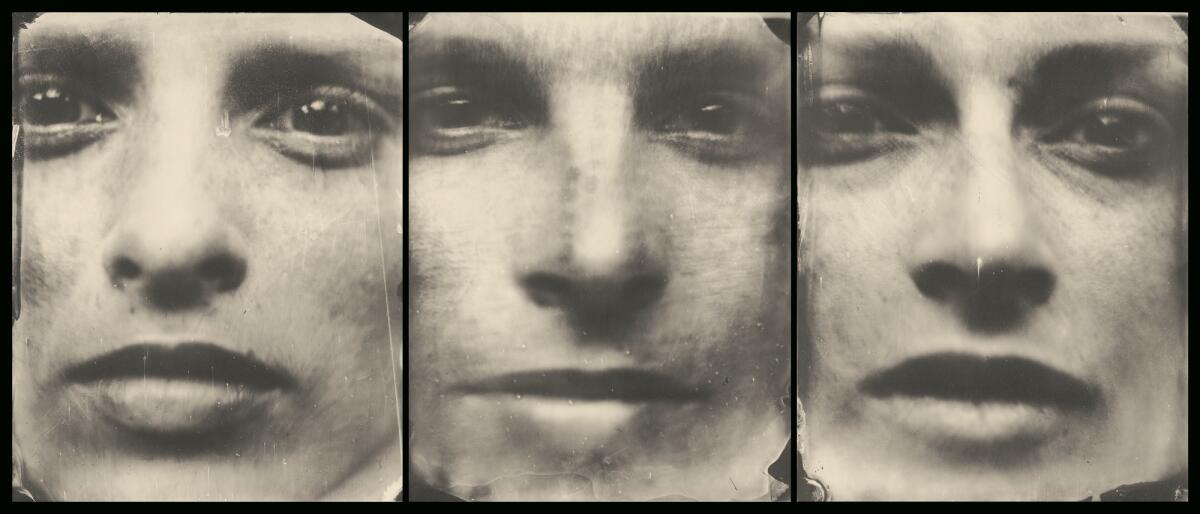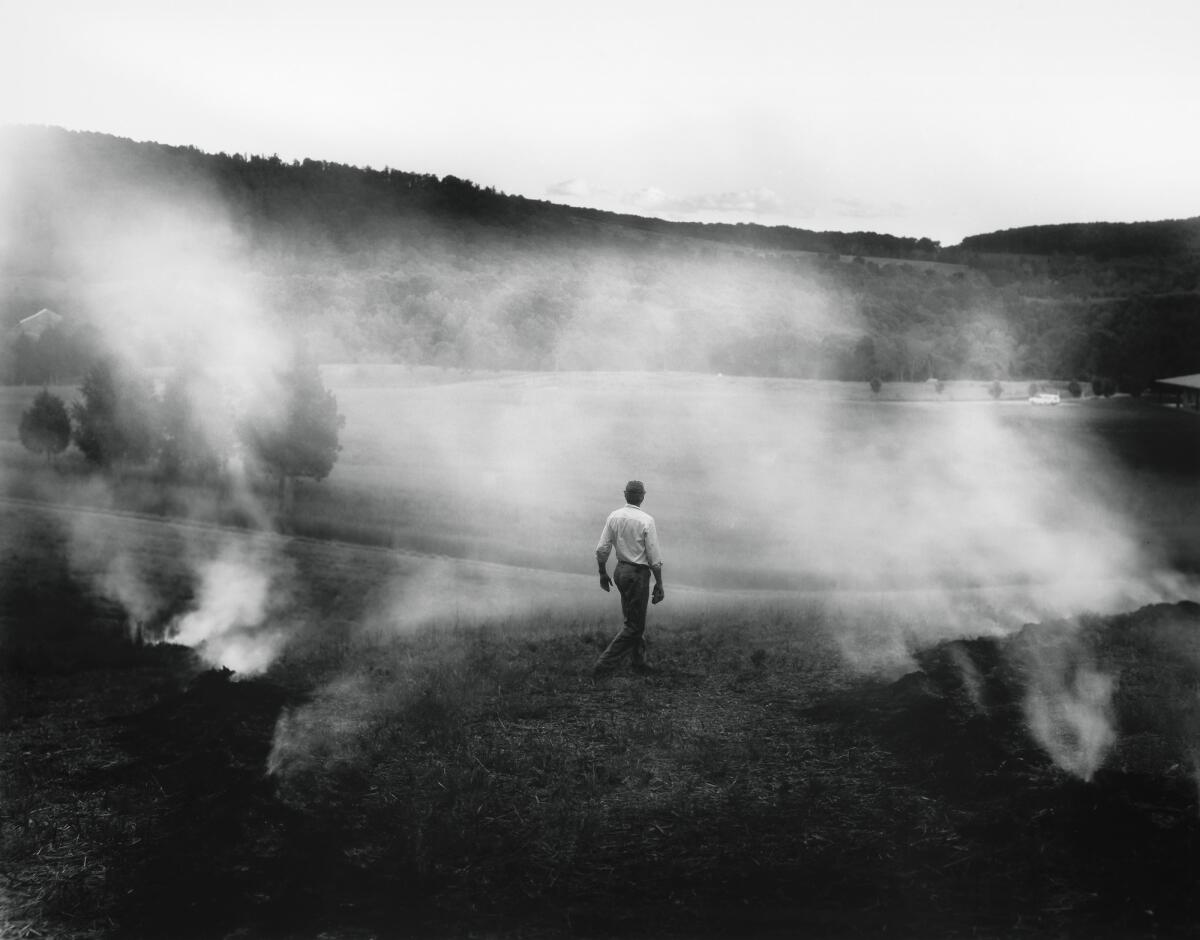Review: A child in ‘The Ditch’ and other mesmerizing moments in ‘Sally Mann: A Thousand Crossings’ at the Getty
“The Ditch,” a 1987 photograph by Sally Mann at the start of her nearly 35-year retrospective exhibition at the J. Paul Getty Museum, sets the stage for much of what follows. Memory collides with forgetfulness in an image just ambiguous enough to pull viewers in and leave them hanging.
Black and white, the entrancing picture shows a young boy lying on his back in a short, shallow, narrow trench that has been clawed into the earth beside a peaceful river. Six more children surround him, silently observing, although all but one of their heads are outside the frame or otherwise obscured.
The one that isn’t looks directly at the camera — and through it at us, as if to see whether we are also closely observing. Another of the children is just emerging, naked or nearly so, from the water at the far end of the ditch.
At the near end, a burst of radiant sunlight glows reflected in the watery foreground puddle. The photograph’s darkly shadowed edges use tonality to focus concentration on the pictorial center. Our viewpoint is almost voyeuristic, as if caught in the act of spying on a furtive event.
This image of kids at play on an ordinary summer day unfurls as a multivalent metaphor for birth — for the delivery of a child into a world where others have gone before. The topical subject is further layered with a suggested epic that stretches to the dawn of time: We stand atop an evolutionary lineage that began tens of millions of years ago when fish developed limbs and tetrapods first crawled onto land from out of the sea.
Here, those evolutionary limbs also play a retrogressive role. The legs and arms of the boy lying in the ditch are bent beneath his torso, hidden from view. Corpse-like, a body with severed limbs and cast into a trench is a discreet echo of renowned wartime photographs that chronicle brutal carnage.
Roger Fenton’s were shot at Sebastopol on the Crimean Peninsula in 1855, Florence Farmborough’s on the Russian Front during World War I. Most immediately for Mann, who was born and has lived most of her 67 years in Lexington, Va., Alexander Gardner’s famous battlefield pictures date to the aftermath of Gettysburg and Antietam. A quiet shock of recognition unfolds, death entering an otherwise sunny summer picture, its intimations of birth and human evolution now joined by insinuations of the grave.
Mann’s photograph was self-evidently composed (unlike some of Gardner’s Civil War pictures, which concealed the artist’s occasional manipulation of the scene). She’s a visual storyteller — the show’s title, “A Thousand Crossings,” comes from the Scottish poet John Glenday — and her work forthrightly partakes of the romantic, sometimes even Gothic expressionism that often characterizes Southern literary traditions. Her subject is always the legacy of the American South, which includes her family.


The show was jointly organized by the National Gallery of Art and the Peabody Essex Museum in Salem, Mass. It is weighted toward photographs made since 2000, which account for roughly two-thirds of 110 works, all but five black-and-white.
Mann first came to widespread attention in a less than auspicious way. In 1992, conservative culture warriors attacked the publication of her fourth book, “Immediate Family,” which includes 13 images (of 65) in which one or more of her three then-young kids is unclothed — a not uncommon occurrence at a cabin on isolated land during a humid summer day. A brilliant picture like “The Ditch” unravels the fearful hysteria that fueled the uproar.
The photograph further exposes the role played by landscape in her art, one that became central after 1994. Some of her scenic views are bland and conventional if beautifully composed — especially the luminous ruins of a once-grand, now-decayed Mississippi plantation built with the awful labor of chattel slavery. Others attempt, with mixed success, to coax the ghosts of history from the land.
Among the most successful are those of Civil War battlefields — 10 large-format images, each printed just over 3 feet by 4 feet, their surfaces lush, dense and blackened. Staring into darkness to parse what you see is not a bad way to describe the act of coming to terms with a defining national event, which still churns today’s social and political environment.
The foreground half of a leafy view of Cold Harbor, where nine days of trench warfare left staggering losses for the Union army, slides downhill from an opaque forest, as if into a grave opening at a viewer’s feet. When printed, flecks of dust on the photographic negative translated into dozens of horizontal lines of scratchy light, which streak across the surface. Neither fireflies nor bullets, though reminiscent of both, the bright, abrasive smudges upend the stillness of the landscape and render it dynamic.
Even the close-up, frame-filling portraits Mann has made during the last decade often have the feel of landscapes. Some are of black men — a fraught territory for an artist who is white and female, given a terrible national history — while others are of her adult children. The “landscapes” of Mann’s intimate yet monumental human heads and bodies are endowed with a fitting gravity, nature being indifferent to our passing vagaries.


Perhaps the show’s most moving photograph records her husband, Larry, turning away as he strides across a grassy field above a shallow vale. Smoke rises on either side from a controlled burn that he has set to replenish depleted earth. Its drifting vapors echo in the clouds that meander above the hilly distant horizon.
You don’t need to know the melancholy of Larry’s late-onset muscular dystrophy, recorded in other portrait photographs here, to read this as a walk through a valley of the shadow of death. The 23rd Psalm emerges among Mann’s literary sources.
The show is very good in articulating the varied photographic processes that Mann, a largely self-taught artist, has employed since the 1980s — many of them technically obsolete. (Death again.) In addition to concise and helpful wall texts, don’t miss the illuminating video in an adjacent gallery. With incarnate history as an aesthetic aim, Mann’s 19th-century techniques often play a material role. The pictures are thrown into high-relief simply by their visual differences, sometimes stark, from today’s sleek digital images.
The artist is a first-generation Virginian from a comfortable background. Her physician father hailed from Dallas; her mother, who ran the bookstore at Washington and Lee University, from Boston.
Maybe that’s why, when facing life lived mostly around the rural town of Lexington, she’s been a kind of Janus figure. A quasi-outsider, she looks back, trying to parse a region’s history as soaked in blood and tragedy as any place on Earth, at the same time as she looks forward into an unknowable tomorrow, sometimes with her growing children as markers of time’s passages.
In Mann’s photographs, past and future exult in their mysteriousness. Yet, an alert and lucid invitation to engage in scrutiny of the constructed image almost always grounds the experience in the present. Even on the occasion when a picture doesn’t finally succeed, the encounter can feel momentous.
♦ ♦ ♦ ♦ ♦ ♦ ♦ ♦ ♦
‘Sally Mann: A Thousand Crossings’
Where: J. Paul Getty Museum, 1200 Getty Center Drive, Brentwood
When: Through Feb. 10; closed Mondays
Admission: Free; parking $15
Info: (310) 440-7300, getty.edu
christopher.knight@latimes.com
ALSO
Review: The longer you look at Lee Mullican’s ‘marble’ drawings, the more — or less — you will see
The biggest entertainment stories
Get our big stories about Hollywood, film, television, music, arts, culture and more right in your inbox as soon as they publish.
You may occasionally receive promotional content from the Los Angeles Times.








